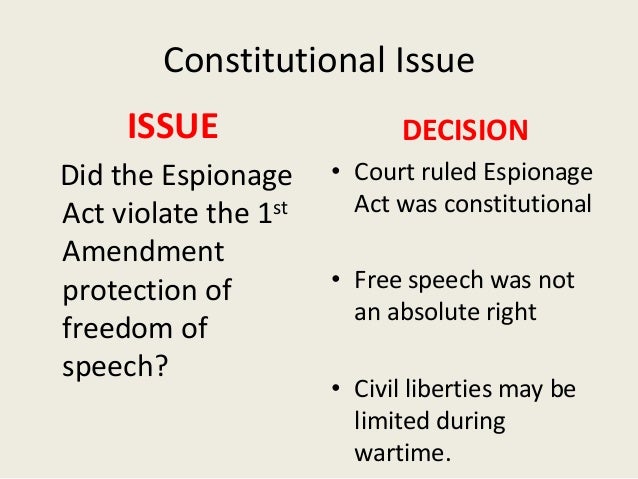Schenck v, United States
Schenck v, United States: Case Summary
Background of The Case
schenck v united states constitutional issue
Facts Issue Constitutional provisions and Federal S… The First Amendment to the U,S Constitution protects the free… 1 Schenck was convicted of violating the Espionage Act, He ha…, Did Schenck’s conviction under the Espionage Act for criticizi…, 1 First Amendment to the U,S, Constitution
Prof, Antonio Gallo gives out 1-2 cases on a monthly basis, You have to comply to his form of briefing cases and have to be short, detailed, and think
Schenck v, United States, 249 U,S, 47, was a landmark decision of the US Supreme Court concerning enforcement of the Espionage Act of 1917 during World War I, A unanimous Supreme Court, in an opinion by Justice Oliver Wendell Holmes Jr,, concluded that defendants who distributed flyers to draft-age men urging resistance to induction could be convicted of an attempt to obstruct the draft, a criminal offense, …
What led to Schenck v United States? – Colors-NewYorkcom
This week’s show features Schenck v United States In a case that would define the limits of the First Amendment’s right to free speech the Supreme Court decided the early 20 th-century case of Schenck v United States The case began, as many do, with an act of Congress, Shortly after the United States entered into World War I, Congress passed the Espionage Act of 1917, It was passed …
Brief Fact Summary, The distribution of leaflets using impassioned language claiming that the draft was a violation of the Thirteenth Amendment of the United States Constitution Constitution and encouraging people to “assert your opposition to the draft” was held not to …
Schenck v, United States drew a distinction on the First Amendment right to freedom of speech, which depends upon the nation’s war status, It also outlined the rights of Congress in regards to its power to raise and maintain the military,
1 Schenck was convicted of violating the Espionage Act, He had printed and mailed 15,000 fliers to draft-age men arguing that conscription the draft was unconstitutional and urging them to resist, 2 Schenck argued that conscription was a form of “involuntary servitude” and thereby outlawed by …
Schenck v, United States
Schenck v, United States
This request was denied Please try again Schenck v United States Which of the constitutional provisions is at issue in Schenck v United States? FROHWERK v UNITED STATES MARCH, 1919 The publisher of a newspaper that had criticized the war is sentenced with a fine and ten years in prison, Years later, in Dennis v, United States 1951, the Court reformulated the clear and present danger
What constitutional issue was raised by the Schenck v
Schenck v, United States
In the landmark Schenck v, United States, 249 U,S, 47 1919, the Supreme Court affirmed the conviction of Charles Schenck and Elizabeth Baer for violating the Espionage Act of 1917 through actions that obstructed the “recruiting or enlistment service” during World War I,
Explorez davantage
| Schenck v, United States: Case Summary – Findlaw | supreme,findlaw,com |
| Schenck v, United States , Case Brief for Law Students | www,casebriefs,com |
| Schenck v, United States , Definition, Facts | www,britannica,com |
| Schenck v, United States :: 249 U,S, 47 1919 :: Justia | supreme,justia,com |
| Schenck v, United States 1919 article , Khan Academy | www,khanacademy,org |
Recommandé pour vous en fonction de ce qui est populaire • Avis
Schenck v, United States

schenck v united states constitutional issue
Schenck v, United States , legal case in which the U,S, Supreme Court ruled on March 3, 1919, that the freedom of speech protection afforded in the U,S, Constitution ’s First Amendment could be restricted if the words spoken or printed represented to society a “ clear and present danger ,”
Schenck v, United States
Schenck v United States 1919 the Supreme Court invented the famous “clear and present danger” test to determine when a state could constitutionally limit an individual’s free speech rights under the First Amendment
Schenck v United States: Defining the limits of free
What happened Schenck v us? United States legal case in which the U,S Supreme Court ruled on March 3 1919 that the freedom of speech protection afforded in the U,S Constitution’s First Amendment could be restricted if the words spoken or printed represented to society a “clear and present danger”
Schenck v, United States 1919 Flashcards
What constitutional issue was raised by the Schenck v United States case quizlet? Schenck v United States 249 U,S 47 1919 was a United States Supreme Court decision that upheld the Espionage Act of 1917 and concluded that a defendant did not have a First Amendment right to express freedom of speech against the draft during World War I
Schenck vUnited States 1919 Flashcards and Study Sets
The Court ruled in Schenck v, United States 1919 that speech creating a “clear and present danger” is not protected under the First Amendment, This decision shows how the Supreme Court’s interpretation of the First Amendment sometimes sacrifices individual freedoms in …
What was the significance of Schenck v United States
Schenck v, United States 1919 article